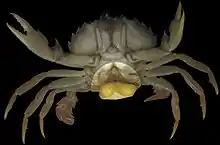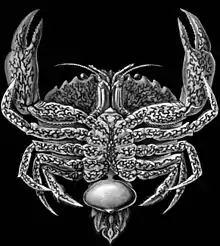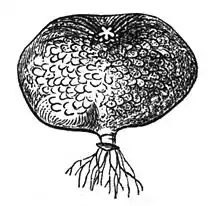Rhizocephala
Rhizocephala are derived barnacles that parasitise mostly decapod crustaceans, but can also infest Peracarida, mantis shrimps and thoracican barnacles, and are found from the deep ocean to freshwater.[1][2] Together with the sister group the Thoracica, they make up the infraclass Cirripedia. Their body plan is uniquely reduced in an extreme adaptation to their parasitic lifestyle, and makes their relationship to other barnacles unrecognisable in the adult form. The name Rhizocephala derives from the Greek roots ῥίζα (rhiza, "root") and κεφαλή (kephalē, "head"), describing the adult female, which mostly consists of a network of thread-like extensions penetrating the body of the host.[3]
| Rhizocephala | |
|---|---|
 | |
| Externa (highlighted) of mature female Sacculina on a female Liocarcinus holsatus | |
| Scientific classification | |
| Kingdom: | Animalia |
| Phylum: | Arthropoda |
| Subphylum: | Crustacea |
| Class: | Maxillopoda |
| Infraclass: | Cirripedia |
| Superorder: | Rhizocephala Müller, 1862 |
| Orders | |
| |
Description and lifecycle

As adults they lack appendages, segmentation, and all internal organs except gonads, a few muscles, and the remains of the nervous system. Females also have a cuticle, which is never shed.[4] Other than the minute larval stages there is nothing identifying them as crustaceans or even arthropods in general. The only distinguishable portion of a rhizocephalan body is the externa; the reproductive portion of adult females.
Nauplii released from adult females swim in water for several days without taking any food (the larva has no mouth and no intestine) and transform into cypris larvae (cyprids) after several moults. Like the nauplii, the cyprids are lecithotrophic (non-feeding).[5] The female cypris in Kentrogonida settles on a host and metamorphoses into a specialized juvenile form called a kentrogon, which carries no visible segmentation and does not have any other appendages than the antennules that are used to attach itself to the host, and whose only purpose is to inject a cell mass named the vermigon into the host's hemolymph through a retractive hollow stylet on their head. The kentrogon stage seems to have been lost in all of the Akentrogonida, where the cypris injects the vermigon through one of their antennules instead.[6] The vermigon grows into root-like threads through the host's tissue, centering on the digestive system and especially the hepatopancreas, and absorb nutrients from the hemolymph. This network of threads is called the interna. The female then grows a sac-like externa, which consists of a mantle, a mantle cavity, an ovary and a pair of passageways known as cell receptacles, extruding from the abdomen of the host.[7][8][9]
In the order Kentrogonida, the virgin externa contains no openings at first. But it soon molts to a second stage that contains an orifice known as the mantle departure, and which leads into the two receptacle passageways — once assumed to be the testes in hermaphroditic parasites before the realization that they were actually two separate sexes — and starts releasing pheromones to attract male cyprids. From inside the body of the male cypris that succeeds in entering the departure, a unique and very short lived male stage called the trichogen emerges through the antennule opening. It is the homologue of the female kentrogon, but is reduced to an amoeboid, unsegmented and cuticle covered mass of cells consisting of three to four cell-types: the dorsolateral, the ventral epidermis, the inclusion cells, and the postganglion. The externa have room for two different males, one for each of the receptacles, which increase the heterozygosity of the offspring. Once inside, the trichogen will shed its cuticle before reaching the end of the passageway.[10][11][12]
In the order Akentrogonida, which form a monophyletic group nested within the paraphyletic Kentrogonida,[13] the males does not develop into a trichogon, and the cypris injects its cell mass through its antennule and directly into the body of the immature externa. The offspring also hatch directly into fully developed cyprids instead of nauplius larvae (except for a few species of kentrogonid rhizocephalans, which hatch into cyprids like the akentrogonids, the kentrogonids have kept their nauplius stage). In species like Clistosaccus paguri, the male injects its cluster of cells which migrates through the connective tissue of the mantle and into the receptacle. But in forms like Sylon hippolytes the receptacle is absent, and the males cells implant in the ovary instead.[14] While only a single males can settle in each receptacle, which is the rule in Kentrogonida, the number of implanted males in Akentrogonida can range from just one to more than ten.[15]
The small cluster of cells injected by the male cypris will once it reach its destination inside the female differentiate into a loosely connected mass of sperm-producing germ cells. Being nothing more but sperm-forming cells, these adult male rhizocephalans represents the simplest form of male in the entire animal kingdom. Mature female externa releases eggs into its mantle cavity where eggs are fertilised by sperm from the hyper-parasitic male(s). Due to the larval sexual dimorphism in the Kentrogonida, the females produce two different egg sizes; small female eggs and larger male eggs.[16][17] It appears the sex determination in Akentrogonida is environmental.[18]
In Peltogasterella gracilis, the externa produces several batches of larvae before it drops off the host, taking the male(s) inside with it. After the original externa disappear, the host moults and the interna grows buds that each develops into a new virgin externa. The females commonly has two cypris cell receptacles. With more than one externa, and new ones replacing the old ones, each female Peltogasterella can receive sperm from numerous males during its lifetime.
The externa is where the host's egg sac would be, and the host's behaviour is chemically altered: it is castrated and does not moult until aged externa(e) drop(s) off. The host treats the externa as if it were its own egg sac.[7] This behaviour even extends to male hosts, which would never have carried eggs, but care for the externa in the same way as females.[7]
Classification
Following the 2001 review by Martin and Davis, the Rhizocephala are ranked as a superorder and divided into two orders which together contain 9 families and two genera which cannot be unequivocally assigned to a family:[19][20][21]
|
Order Akentrogonida Häfele, 1911
|
Order Kentrogonida Delage, 1884
|
 Clistosaccus paguri (Akentrogonida)
Clistosaccus paguri (Akentrogonida) Sacculina carcini (Kentrogonida)
Sacculina carcini (Kentrogonida)
External links
 Data related to Rhizocephala at Wikispecies
Data related to Rhizocephala at Wikispecies Media related to Rhizocephala at Wikimedia Commons
Media related to Rhizocephala at Wikimedia Commons
| Wikisource has the text of the 1905 New International Encyclopedia article "Rhizocephala". |
References
- Pérez-Losada, Marcos; Høeg, Jens T; Crandall, Keith A (17 April 2009). "Remarkable convergent evolution in specialized parasitic Thecostraca (Crustacea)". BMC Biology. 7: 15. doi:10.1186/1741-7007-7-15. PMC 2678073. PMID 19374762.
- Walker, Graham (July 2001). "Introduction to the Rhizocephala (Crustacea: Cirripedia)". Journal of Morphology. 249 (1): 1–8. doi:10.1002/jmor.1038. PMID 11410936.
- "Etymology of the Latin word Rhizocephala". MyEtymology. Retrieved June 24, 2011.
- Bresciani, José; Høeg, Jens T. (July 2001). "Comparative ultrastructure of the root system in Rhizocephalan barnacles (Crustacea: Cirripedia: Rhizocephala)". Journal of Morphology. 249 (1): 9–42. doi:10.1002/jmor.1039. PMID 11410937.
- Martin, Joel W.; Olesen, Jørgen; Høeg, Jens T.; Høeg, Jens (2014). Atlas of Crustacean Larvae. JHU Press. p. 99. ISBN 978-1-4214-1197-2.
The Acrothoracica and Rhizocephala have exclusively lecithotrophic nauplii. The cypridoid larva is always lecithotrophic
- Glenner, Henrik; Høeg, Jens T. (2002). "A Scenario for the Evolution of the Rhizocephala". Modern Approaches to the Study of Crustacea. pp. 301–310. doi:10.1007/978-1-4615-0761-1_42. ISBN 978-1-4613-5228-0.
- Henrik Glenner & Jens T. Høeg (2002). "A scenario for the evolution of the Rhizocephala". In Elva Escobar-Briones & Fernando Alvarez (ed.). Modern Approaches to the Study of Crustacea. Springer. pp. 301–310. ISBN 978-0-306-47366-1.
- Elumalai, V.; Viswanathan, C.; Pravinkumar, M.; Raffi, S. M. (2014). "Infestation of parasitic barnacle Sacculina spp. in commercial marine crabs". Journal of Parasitic Diseases. 38 (3): 337–339. doi:10.1007/s12639-013-0247-z. PMC 4087306. PMID 25035598.
- Noever, Christoph; Keiler, Jonas; Glenner, Henrik (July 2016). "First 3D reconstruction of the rhizocephalan root system using MicroCT". Journal of Sea Research. 113: 58–64. Bibcode:2016JSR...113...58N. doi:10.1016/j.seares.2015.08.002.
- Hoeg, J. T. (24 September 1987). "Male Cypris Metamorphosis and a New Male Larval Form, The Trichogon, in the Parasitic Barnacle Sacculina carcini (Crustacea: Cirripedia: Rhizocephala)". Philosophical Transactions of the Royal Society B: Biological Sciences. 317 (1183): 47–63. Bibcode:1987RSPTB.317...47H. doi:10.1098/rstb.1987.0047.
- Gould, Stephen Jay (2010). Leonardo's Mountain Of Clams. Random House. p. 315. ISBN 978-1-4090-0038-9.
In Sacculina and close relatives, the virgin externa contains no opening
- Klepal, Waltraud (1999). "A Review of the comparative anatomy of the males in cirripedes". Oceanography And Marine Biology. CRC Press. pp. 250–304. ISBN 978-0-203-40068-5.
The 'trichogon' was discovered, a new post-cypris male larval form which may be considered as an extremely reduced dwarf male
- Glenner, Henrik; Høeg, Jens T.; Stenderup, Jesper; Rybakov, Alexey V. (May 2010). "The monophyletic origin of a remarkable sexual system in akentrogonid rhizocephalan parasites: A molecular and larval structural study". Experimental Parasitology. 125 (1): 3–12. doi:10.1016/j.exppara.2009.09.019. PMID 19786021.
- Castro, Peter; Davie, Peter; Guinot, Danièle; Schram, Frederick; Klein, Carel von Vaupel (2015). "Fig. 71-12.24. Rhizocephalan life cycle: A-J, life cycle of the akentrogonid rhizocephalan". Treatise on Zoology - Anatomy, Taxonomy, Biology. The Crustacea, Volume 9 Part C (2 vols): Brachyura. BRILL. p. 714. ISBN 978-90-04-19083-2.
- Thiel, Martin; Wellborn, Gary (2018). The Natural History of the Crustacea: Life Histories. Oxford University Press. p. 385. ISBN 978-0-19-062028-8.
- Nagler, Christina; Hörnig, Marie K.; Haug, Joachim T.; Noever, Christoph; Høeg, Jens T.; Glenner, Henrik (5 July 2017). "The bigger, the better? Volume measurements of parasites and hosts: Parasitic barnacles (Cirripedia, Rhizocephala) and their decapod hosts". PLoS ONE. 12 (7): e0179958. Bibcode:2017PLoSO..1279958N. doi:10.1371/journal.pone.0179958. PMC 5497970. PMID 28678878.
- Korn, O. M.; Shukalyuk, A. I.; Trofimova, A. V.; Isaeva, V. V. (September 2004). "Reproductive Stage of the Life Cycle in the Rhizocephalan Barnacle Polyascus polygenea (Crustacea: Cirripedia)". Russian Journal of Marine Biology. 30 (5): 328–340. doi:10.1023/B:RUMB.0000046552.07712.02.
- Leonard, Janet L. (2018). "Phylogenetic Character Distribution". Transitions Between Sexual Systems: Understanding the Mechanisms Of, and Pathways Between, Dioecy, Hermaphroditism and Other Sexual Systems. Springer. pp. 224–5. ISBN 978-3-319-94139-4.
- Martin, Joel W.; Davis, George E. (2001). An Updated Classification of the Recent Crustacea. CiteSeerX 10.1.1.79.1863.
- Daphne Cuvelier (2009). M. Schotte; C. B. Boyko; N. L. Bruce; G. C. B. Poore; S. Taiti; G. D. F. Wilson (eds.). "Rhizocephala". World Marine, Freshwater and Terrestrial Isopod Crustaceans Database. World Register of Marine Species. Retrieved June 3, 2011.
- "Order Akentrogonida Häfele, 1911 (6 families)". Animal biodiversity: An outline of higher-level classification and survey of taxonomic richness. Magnolia Press. 2011. p. 166. ISBN 978-1-86977-849-1.
